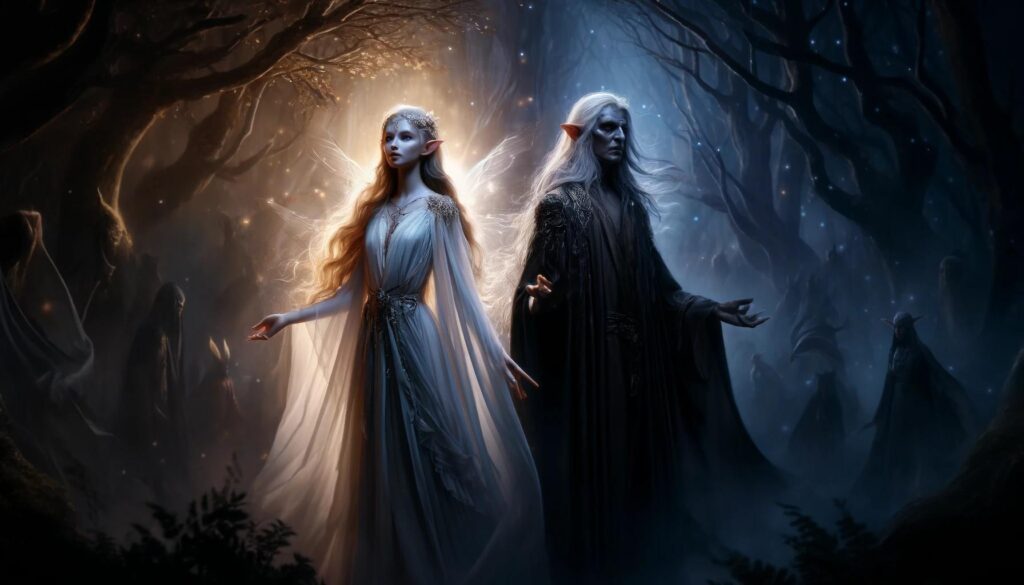
Ah yes—elves and fairies in Norse myth: ancient, mystical, and not nearly as sparkly or sweet as the Victorian versions. 🌙✨ What we think of today as delicate winged fairies or elegant Tolkien-esque elves started much deeper—and darker—in the misty roots of Norse and Germanic folklore. Let’s peel back the layers of myth and time to see what the old sagas really say.
🧝♂️ Elves in Norse Myth: The Álfar
🔹 Who Were They?
In Old Norse mythology, elves are known as the Álfar (singular: álfr). They were supernatural beings—not quite gods, not quite mortals—with immense beauty, long life, and magical powers.
There are two main types (according to the Prose Edda by Snorri Sturluson):
- Ljósálfar (“Light Elves”)
- Dwell in Álfheimr, a heavenly realm.
- Described as fairer than the sun, radiant, and semi-divine.
- Associated with light, fertility, healing, and perhaps even inspiration or wisdom.
- Dökkálfar (“Dark Elves”)
- Live underground, or possibly in Svartálfheimr (sometimes conflated with dwarves).
- Described as black as pitch, and often linked with death, mischief, or shadowy powers.
- These may have evolved into the concept of malevolent underground spirits.
💡 Important: Elves were not little woodland creatures in Norse myth. They were respected, feared, and could be either benevolent or dangerous.
🧚♀️ Fairies in Norse and Germanic Folklore
While “fairy” is a more Celtic term, Scandinavian and Germanic cultures had similar beings—and the lines between elves, fairies, and spirits were very blurry.
Similar Beings Included:
- Huldufólk (“Hidden People”) – Icelandic belief in invisible, elf-like people living in rocks and hills. Still respected today!
- Landvættir – Nature spirits or guardians of specific places.
- Disir / Alfrúnar – Female spirits or elf-women with prophetic or protective roles.
- Nisse / Tomte – House spirits that evolved from older elf beliefs.
These beings were often:
- Capable of blessing or cursing humans
- Involved in fertility, birth, sickness, and dreams
- Known to punish disrespect—they didn’t like their hills or homes being disturbed
🕯️ Offerings and Elf Worship
In Viking and early medieval times:
- People left food, milk, or ale for elves or spirits, especially during festivals like Yule.
- Burial mounds were thought to be places elves or spirits dwelled.
- Some scholars believe ancestor worship and elf veneration overlapped—elves may have originally been deified ancestors.
In fact, the word álfr is sometimes used in skaldic poetry to describe human warriors or noble dead.
🧙♂️ Tolkien’s Take: Elves Reimagined
J.R.R. Tolkien, a Norse mythology nerd, took inspiration from the Ljósálfar to create his immortal, wise, elegant elves in The Lord of the Rings. His elves combine:
- The radiant beauty of the light elves
- The magical wisdom of old Norse beings
- A touch of Celtic sidhe (fae folk) melancholy and grace
He also revived Álfheimr as a true realm of light and peace.
⚔️ The Shift: From Sacred to Storybook
Over centuries, especially under Christian influence:
- Elves and spirits went from respected nature-beings to tricksters, pests, or devils.
- By the time of Shakespeare (A Midsummer Night’s Dream), elves and fairies were small, whimsical, and mischievous.
- The Victorian era cemented the glittery, harmless fairy image we have today.
But in older Norse belief, these beings were mysterious, powerful, and deeply intertwined with nature, fate, and the unseen world.
🧝♀️ Final Thought
Elves and fairies in Norse myth weren’t just fantasy creatures—they were reflections of the human relationship with the natural and supernatural. They could bless crops, guard families, whisper dreams… or haunt, hex, and hide forever just beyond your sight.
Want to explore elven magic, real-world rituals to honor nature spirits, or dive into elf-shot legends (where sickness was blamed on invisible arrows)? Say the word—I’ve got the mead and moonlight ready. 🌙🧝♂️🌿